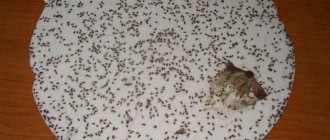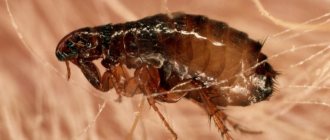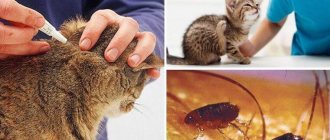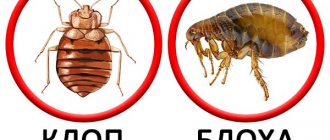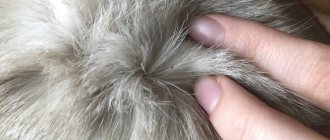- Meet the human flea
- Description of the parasite
- Do fleas live on humans?
- Reasons why fleas cannot live on humans
- Where do human fleas live?
- Exception to the rule
- Why are human fleas dangerous?
- How to protect yourself from parasites?
The main carriers of fleas into homes are domestic cats and dogs. Insects also move into the apartment on clothes and shoes, enter through basements and open windows. They annoy not only pets, but also other family members, leaving painful bites. Therefore, the question arises whether fleas live on humans, or whether these ectoparasites just come to visit.
Meet the human flea
Scientists have described 2,086 species, 200 genera and 15 families of insects. The official species “human flea” exists and belongs to the common family.
Common types of fleas
- Felines;
- Canine;
- Rat;
- Rabbit;
- Human.
However, do not rush to conclusions that there are fleas on people. The name of the insect does not indicate its habitat. All of the above types of ectoparasites feed on the blood of any mammals. For example, cat fleas bite cats, dogs, humans, pigs, and cows.
Are fleas transmitted from dogs to humans?
Are dog fleas transmitted to people? More likely no than yes. However, a situation often occurs when cat fleas spread from dogs to people. The situation is generally identical to that of a kitten or cat becoming infected with fleas.
If you are afraid that fleas from a dog or cat can spread to a person, you should first treat surfaces that the animal frequents, and only then treat the animal itself. After the end of the treatment cycle, 2-3 weeks later it is necessary to re-treat the entire apartment in order to kill all the grown larvae and adult fleas emerging from the cocoon.
Fleas from animals can pass to humans under any circumstances, therefore, in addition to treating the area around the animal’s bedding and treating the pet itself, it is imperative to disinfest the entire apartment for fleas. At first glance, it may seem that there are no longer fleas in the apartment, and that they only remain on the animal. In fact, imago (adult) fleas make up no more than 20% of the entire population. Most of it consists of scattered eggs, larvae and pupae. And they can end up not only in the animal’s fur, but also in the pile of the carpet, in the weave of the sofa upholstery, etc. You may not be aware of their presence for a long time until a new viable generation of fleas begins to bite people in a chair, sofa or mattress. It is better if the apartment is treated for fleas by a specially trained person - a specialist entomologist or disinfector, however, with proper preparation, anyone can do this.
It is important to consider that if you begin to treat the animal before treating the apartment, but do not treat the carpets and sofa, this may lead to fleas moving from the animal and starting to actively bite people in the room, and may also spread to neighbors. Are animal fleas transmitted to humans in this case? Most often, they disperse in this way, becoming more tenacious and adapted to unfavorable conditions.
Description of the parasite
The homeland of the human flea is South America. In the past, it was one of the main carriers of plague along with the rat flea.
The length of the body does not exceed three millimeters, the color is dark brown. A durable chitinous shell protects from damage, and bristles on the paws provide adhesion to animal fur.
The insect's jumps reach 30 centimeters in height and half a meter in length. The human flea has an excellent reaction, so it is almost impossible to catch it. He prefers cats and dogs as victims, but sometimes he doesn’t mind feasting on human blood.
The female is capable of laying up to 500 eggs. Metamorphosis into an adult insect takes from 2 weeks to one year.
Features of parasitism
The life cycle of fleas does not depend on a specific animal. They need blood to reproduce. They receive the necessary portion and return to their usual habitat. In city apartments this could be:
- pet beds and houses:
- mattresses;
- sofas and armchairs;
- textile toys;
- spaces behind furniture;
- cracks in the floor and poorly pasted wallpaper.
The flea remains viable even if it does not receive blood for a long time. In this case, suspended animation (hibernation) does not occur. The parasite loses the ability to reproduce, but continues to move in search of food. Fleas recognize their prey thanks to their excellent sense of smell and sensitivity to temperature fluctuations and vibrations.
Reasons why fleas cannot live on humans
- Temperature
- No clues
- Precautionary measures
- Protection of future offspring
Fleas love warmth. The human body temperature is lower than that of cats, dogs and other mammals, so it is uncomfortable for insects to live on it.
Fleas require a thick coat of fur to stay on the victim's body and not fall off. Human skin is smooth. Can fleas live in human hair? No, either, because human hair is not as thick as animal hair.
Unlike other insects (ticks, mosquitoes, bedbugs, lice), fleas do not secrete an anesthetic substance during a bite. The affected person makes sudden movements and drives the insect away. The flea is forced to jump to avoid being caught. There is no point in living where you are constantly disturbed.
In order to preserve her offspring, the female flea lays eggs in secret corners: pet fur, carpets, baseboards, under beds and sofas. If they multiply on a person’s body and hair, then due to the lack of attachment, the eggs simply end up on the floor.
Where, when and how can you get infected with fleas?
A person may well encounter blood-sucking insects almost anywhere: in his own home, outdoors in the forest, at work in the agricultural industry, or when going hunting.
Most often, fleas are transmitted to people from their pets - cats or dogs that live in the house. According to statistics, 3 out of 4 pets are infected with fleas. However, it is not necessary that these are domestic animals. The primary source may well be rodents and stray street animals.
The largest number of all parasites and their larvae live where the domestic animal sleeps and rests. This is a booth, bed, bedding, playpen or enclosure. After all, for fleas these places are the most comfortable for breeding, feeding and shelter.
For example, dog fleas often jump onto a person while in a kennel. Here the females lay eggs and very quickly begin to want to eat again. Even a person just passing by can easily become their victim.
Other habitats for fleas are:
- Natural resting and nesting places for animals: burrow, hollow, nest. Being near these places, hunters, biologists, and loggers risk being infected with fleas.
- Agricultural farms and other livestock complexes. There are a lot of fleas on rabbit farms and fur farms. Even though disinfestation is often carried out in such places, many workers are still attacked and bitten by fleas.
- Natural places and shelters for small rodents: meadows, ravines in the forest, fields. Usually a person does not notice the burrows of these animals and thus becomes a victim of a huge number of fleas.
- Premises infested with fleas: private and apartment buildings, their attics and basements.
Exception to the rule
There is a separate type of ectoparasite that can live in the human body for a short time. This is a sand flea that inhabits tropical beaches. Distributed in Brazil, Nigeria, India. You should be careful when visiting tropical countries.
The sand flea strongly bites the skin and, thanks to its one-millimeter body length, easily penetrates into the deep layers, reaching blood vessels. It lives inside the human body for up to 7 days until the eggs finish maturing.
The sand flea is dangerous because it causes a serious inflammatory disease - sarcopsillosis.
How do fleas transmit helminths?
There is no doubt about whether fleas carry worms. However, how can such tiny insects become carriers of parasitic worms? Very simple. Typically, infection occurs when a flea moves across a surface contaminated with helminth feces. In this case, the bloodsucker can “pick up” even smaller worm eggs, from which, after entering the insect’s body, helminths hatch and begin to wait for the opportunity to move into a larger organism suitable for their life.
Fleas carry worms and turn into slightly irregular fleas. They are less mobile when compared with non-infected relatives. Therefore, such “slow” insects are easier to catch. An animal that licks fur and bites parasites out of it often swallows slow-moving, infected fleas. As a result, the flea is safely digested, and the parasitic worm attaches to the intestines.
Important:
Cucumber tapeworms are hermaphrodites, meaning they do not need a partner to actively reproduce. An infected pet itself becomes a distributor of helminths. Therefore, it is important to promptly identify the infection, and many veterinarians recommend treating the animal simultaneously with flea treatment in order to prevent it from developing worms.
Thus, to the question of how fleas transmit worms, the answer is - in most cases, within themselves. And from there, helminths penetrate the bodies of domestic animals and humans. To prevent this from happening, it is necessary to poison the pet’s fleas in a timely manner and thoroughly treat the living space. It is better to entrust the implementation of the last procedure to the specialists of a sanitary company, who use high-quality and effective products in their work and guarantee results.
Why are human fleas dangerous?
Although fleas do not live on the human body, they can bite him at any time. Since the insect jumps to a height of up to 30 centimeters, the affected areas are usually the legs. If fleas have settled in the bed, bite marks will appear all over the body.
A red-pink spot with a black dot in the center appears on the affected area. It hurts and itches. The marks of numerous bites look terrifying. There is a risk of developing inflammatory processes and allergies.
Human fleas carry the following diseases:
- Tuberculosis;
- Typhus;
- Plague;
- Brucellosis;
- Hepatitis B and C;
- Encephalitis.
For people with weakened immune systems and children, insects pose a serious threat. Fleas also carry protozoan helminths (nematodes).
How to protect yourself
Animal owners especially often have to deal with the consequences of fleas. But no one can be immune from insects. If fleas decide to live in a house, comprehensive treatment of the home is needed.
It includes:
- freeing pets from insects:
- washing all bedspreads, blankets, curtains, processing upholstery and covers;
- processing the yard and buildings, cutting the grass;
- dismantling and processing of storage rooms and closets.
You will have to shake up the whole house to prevent contamination of secluded places where insects like to live.
To avoid getting infected, you need to avoid going to landfills and the habitats of stray animals, and avoid contact of domestic cats and dogs with them. Anyone who ends up in such places should be inspected and their clothes should be thoroughly shaken out before returning home.
Head disinfection
Fleas of any kind, including human ones, do not live in human hair. To remove individual individuals, it is enough to wash your hair regularly. It is useful to use tar soap or shampoos that are sold in pharmacies against lice and nits.
Treatment of wounds from bites
Special wound treatment is only relevant in cases of infection and severe scratching. In most cases, wounds heal within 1-3 days without any trace.
If there are signs of an allergy, you should consult an allergist, especially if irritation persists after taking antihistamines.
You can lubricate the damage with the following preparations:
- iodine;
- Calamine;
- Fenistil;
- tinctures of chamomile, plantain.
If severe itching occurs, the doctor may prescribe medications with glucocorticosteroids for local (Sinaflan, Hydrocortisone) or oral use.
It is better not to use such means on your own.
What can you get infected with?
The likelihood of contracting a fatal disease from the bite of a random flea is small, but there is always a risk. When a representative of a blood-sucking species penetrates and penetrates the skin, further developments can be very diverse and unpredictable.
Bacterial infections
The danger of fleas to humans is that they are capable of transmitting the following infections:
- Plague. An extremely contagious disease caused by the bacterium Yersinia pestis. Fleas are carriers of this pathology with a high probability of death. This quarantine infection is extremely severe and includes fever, damage to the lymphatic system, lungs and other internal organs.
- Salmonellosis. An infectious disease that primarily affects the gastrointestinal tract and is caused by Salmonella. Chicken fleas are often carriers of the pathogen. This bacterial pathology is characterized by symptoms of acute intoxication, accompanied by diarrhea, vomiting, dermatological rashes and complete digestive disorders.
- Tularemia. The causative agent of this zooanthroponotic infection is the bacterium Francisella (Francisella tularensis). The carriers of this disease are blood-sucking insects, including fleas. Tularemia is accompanied by severe symptoms of general intoxication. It affects the lymphatic system, affecting the organs of vision and breathing.
- Listeriosis. A deadly infection caused by the bacterium Listeria monocytogenes. Most often, infection occurs through contaminated water and food products of animal origin. Although fleas are also occasionally carriers of it. There are four forms of the disease: glandular, gastroenteric, nervous and septic.
- Brucellosis. An infectious disease characterized by an acute course, the causative agent of which is microorganisms of the genus Brucella. The pathogen enters the human body through animal products that have not undergone high-quality heat treatment. And sometimes this disease is carried by fleas or other blood-sucking animals.
Blood-sucking, as carriers of diseases, are quite often responsible for fungal pathologies.
Diseases caused by protozoa
If you are interested in what diseases fleas carry, you can discover such a pathology as Chagas disease. It is a parasitic disease caused by the protozoan Trypanosoma cruzi. A person becomes infected with this disease through the bites of bedbugs or fleas. This pathology is more often diagnosed in the tropics. Chagas disease affects the nervous, cardiovascular and gastrointestinal systems.
Often causes swelling of the brain.
Viral diseases
Fleas are dangerous to humans because they can cause viral encephalitis. Most often, human infection occurs from mammals through ticks, less often fleas. This disease causes damage to brain tissue. If therapy is not started in a timely manner, then for a person this is fraught with the development of paralysis.
Is it possible to become infected with HIV or hepatitis C?
HIV and the hepatitis C virus cannot exist outside the human body. Theoretically, if a blood-sucking parasite first bit a sick person and then squirted a portion of blood into a healthy one, then infection could occur. But a bite does not imply such a mechanism.
In addition, even if we consider that there is a small portion of infected blood in the parasite’s proboscis, there is nothing to worry about, since the hepatitis or HIV virus dies in the external environment within a few minutes. Thus, infection with these terrible viral infections does not occur through blood-sucking insects.
Do they carry rabies?
Some people are concerned not only about themselves, but also about the health of their pets, so they are interested in whether fleas carry rabies. When a blood-sucking animal comes into contact with a pet, infection successfully occurs. Most often, rabies occurs in dogs and this forces them to be euthanized.
Worms
Worm parasites (helminth eggs) are actively carried by fleas. If dog fleas containing tapeworm larvae penetrate into the human oral cavity, then infection is inevitable. Blood-sucking parasites temporarily carry helminths. Once worms settle in the human body, they can live there for about a year without causing any symptoms.
Another clinical case of helminth infection through contact is rat tapeworm. It is detected in fleas living on rats. The helminth egg is swallowed by the larva of the blood-sucking parasite, and then a worm is formed from the egg inside it. Human infection occurs when a flea with a helminth enters the oral cavity.
Prevention
As you know, it is better to prevent a disease than to treat it. Therefore, pet owners are recommended to occasionally examine their pet for the presence of blood-sucking pests on its fur.
You need to periodically inspect your cat's bedding and the places where it spends most of its time. Be attentive to the animal's behavior.
If a cat is infected with fleas, then you need to immediately start fighting the bloodsuckers in order to completely get rid of them. To eliminate fleas in cats, you can use the following products:
- drops on the withers;
- sprays;
- shampoos for animals;
- anti-flea collars.
After using any of the products, the cat does not need to be washed for three days. Your veterinarian will tell you what to do and which anti-flea remedy to choose, or a specialist at a veterinary pharmacy will advise you.
Fleas are transmitted from cats to humans, from animal to animal, but in addition to treating animal hair, it is also recommended to treat the apartment. Fleas can hide in upholstered furniture, carpets, baseboards, and secluded corners. Getting rid of fleas indoors can be difficult. It is necessary to vacuum the entire room, wash soft toys, clean upholstered furniture, and carry out a complete wet cleaning of the room. Afterwards, the apartment needs to be treated with special anti-parasite compounds. If there are too many fleas, it is recommended to contact an exterminator. This will most likely require temporary relocation of people to another place of residence.
To avoid re-infection of animals, you need to follow preventive measures:
- Treat the animal with anti-flea drugs once a month.
- Regularly clean and inspect your cat's bedding or bed for the presence of fleas.
- Maintaining cleanliness in the apartment.
- Avoid contact between indoor cats and street cats so that the animal cannot become infected with fleas from them. Street cats and their habitats (near entrances, in basements) are the most contagious.
- If fleas are detected, you need to take action to combat the parasites in order to get rid of them without allowing them to reproduce.
Follow simple rules of prevention, and then you will protect your furry pet, yourself and your home.
Methods of disposal
Parasites cannot live permanently on the body, head, or hair of people. To avoid blood-sucking attacks, repellents are used. There are also various preparations for killing parasites that should be used to treat premises.
In stores you can choose a suitable product that will help remove insects from your home.
Sprays and aerosols
Treatment with these compounds will protect even with a large concentration of blood-sucking insects.
Read also: Amaryllis has faded, what to do next
The most popular:
- Biban;
- Off-extreme;
- Gardex;
- Gall-Rat.
Aerosol Raptor is used to kill fleas in the house.
The insect repellent spray is distributed more evenly on the skin and clothing.
The aerosol helps to quickly get rid of parasites. The most popular is Raptor. Solfak, Tetrix, and Effective Ultra are also used.
After treatment, the home should be washed thoroughly to remove any remaining toxic substances. You cannot use the first disinfestation agent you come across, as this can lead to mutation of parasites, which will complicate further fight against them.
Powders and suspensions
Powdered preparations and suspensions give results a little slower. For spraying, use a special anti-dust tool for powder insecticides. The carpet is thoroughly vacuumed the next day.
Folk remedies
When you cannot use chemicals, you can resort to folk remedies. A mixture of vinegar and water in equal parts is an effective protection against fleas. The solution is used to treat wooden surfaces.
To repel blood-sucking parasites, dry wormwood with inflorescences can be placed in the corners along the baseboards.

